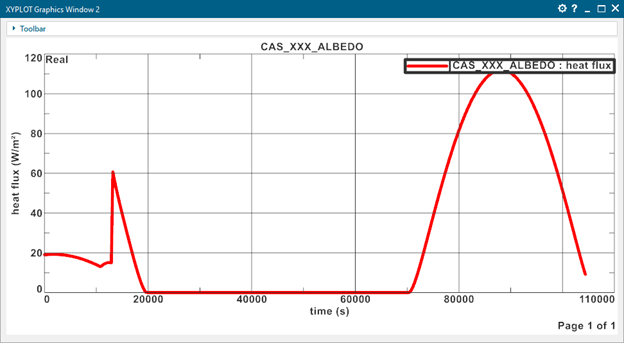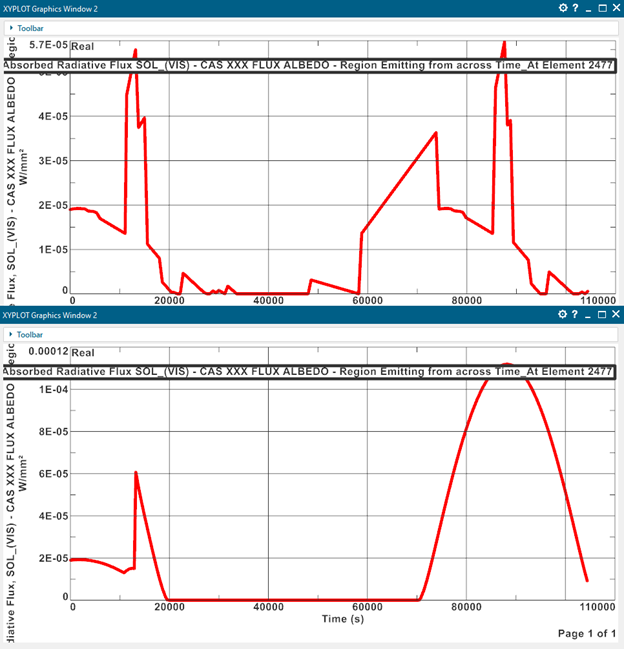March 2024 critical fixes
March 2024 fixes were published on 12 March 2024. All critical fixes listed here were fixed for versions 2406.0, 2312.4, 2306.9 unless otherwise noted.
Bug 66962: Wrong solid temperature when adiabatic wall temperature is coupled to solid walls with convection coupling BC
The finite element implementation for convection couplings did not consider partial area convection (one wall element connected to multiple duct elements) when rotational effects were specified (relative temperature reference frame or adiabatic wall temperature options). When rotational effects are considered for convection, an extra heat term is added to the wall and duct which is proportional to the heat transfer coefficient and convective area. Before the fix, the convective area was ignoring the partial view factor between the wall and a duct element. It was assumed that the convective area is always equal to the wall element area when calculating the extra heat term.
Task 74014: Multiphysics model containing orthotropic material with cylindrical material orientation produces incorrect temperatures
Prior to the fix, an orthotropic material defined with cylindrical material orientation was not supported by the thermal solver for Simcenter 3D Multiphysics solutions. In such cases, a Cartesian material orientation was used instead.
Bug 87738: Support duct node convection coupling applied on internal lines for the finite element method
The finite element formulation for the convective area of convective couplings was updated to behave like thermal convecting zone, thermal stream, and thermal void loads. If the free area of a selection is zero typically due to internal line treatments (i.e., subtraction of the thickness from both sides of the edge multiplied by the length of the edge is zero), then we keep the connection in the thermal solver but set the convective area to zero. Before the fix, the internal line was not accounted for by the solver (i.e., the area of the edge written to the INPF file was used when the remaining area was zero). Under these conditions, the thermal solver computed incorrect temperatures. This was fixed.
Bug 87798: Wrong radiative flux in post-processing for table-dependent radiative heating with more than 10 data points
Before the fix, absorbed fluxes and heat loads were incorrectly processed for time-dependent radiative heating tables with more than ten data points. For such scenarios, the radiative heating tables were mangled due to incorrect sorting. After the fix, the tables are sorted properly. Note that this bug was purely a post-processing one which affected absorbed fluxes and heat loads in the results and report files, and it did not affect the computed temperatures.
Here is an example of a radiative heating definition that evolves in time:

Here is the resulting absorbed flux in time for one element, before fix (top) and after fix (bottom):

Bug 88249: Wrong temperature is computed when convection to environment is applied to axisymmetric external edges and a stream, void and/or zone is applied to the internal edges of the same axisymmetric elements
The finite element formulation for the convective area of a convection to environment BC was not properly accounting for internal line configurations. The convective area now accounts for the number of instances for blades (plane stress elements) and the free area on an internal line (subtraction of the thickness from both sides of the edge multiplied by the length of the edge).
Bug 88251: Time-dependent total pressure applied to duct end nodes is incorrectly interpolated on duct elements in a transient analysis
The pressure applied to duct elements is interpolated from duct end node values. For transient analyses with time-dependent total pressure defined, the duct pressures were not properly interpolated, i.e. they lagged by one timestep. This was fixed.
